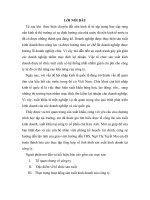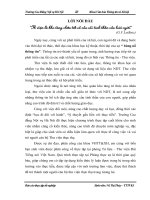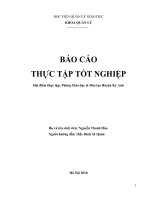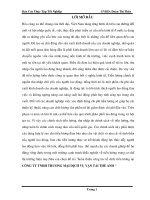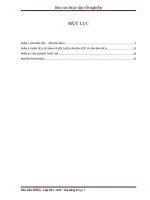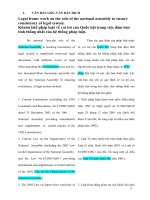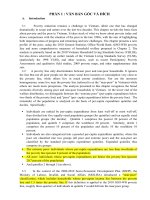Báo cáo thực tập tốt nghiệp tiếng anh (40)
Bạn đang xem bản rút gọn của tài liệu. Xem và tải ngay bản đầy đủ của tài liệu tại đây (122 KB, 23 trang )
Table of content
ACKNOWLEDGEMENT............................................................................................................
i
ABSTRACT..................................................................................................................................
ii
TABLE OF CONTENT................................................................................................................
iii
Part I: Introduction.......................................................................
1
1.Justification of the Study............................................................................................................
1
2.Aims and Objectives of the Study..............................................................................................
1
3.Methods of the Study.................................................................................................................
1
4.Scope of the Study.....................................................................................................................
1
5.Format of the Study....................................................................................................................
2
Part II: ThE STUDY.........................................................................
3
CHAPTER 1: THEORETICAL BACKGROUND....................................................................
3
1.1. Definition of Reading.............................................................................................................
3
1.2.Reading Comprehension.........................................................................................................
3
1.3.Factors That Affect the Learner Reading Success or Failure..................................................
4
1.3.1.Subjective Factors................................................................................................................
4
1.3.1.1.Motivation.........................................................................................................................
4
1.3.1.2.Reading Purpose...............................................................................................................
4
i
1.3.1.3.Reading Skills...................................................................................................................
4
1.3.1.4.Reading Strategies.............................................................................................................
4
1.3.2.Objective Factors.................................................................................................................
5
1.3.2.1.Reading Material...............................................................................................................
5
1.3.2.2.Teacher Teaching Method.................................................................................................
5
1.3.3. Summary.............................................................................................................................
5
CHAPTER 2: THE STUDY..........................................................................................................
6
2.1.The Subject and the Characteristics of the English Textbook of the Second Year Students...
6
2.2.Some Problems in Reading Material.......................................................................................
6
2.2.1.Problem in Reading Material...............................................................................................
6
2.2.2.Problem in Students’ Reading Strategies.............................................................................
7
2.2.2.1.The Ways Students Read the Text.....................................................................................
7
2.2.2.2.The Ways Students Deal with the Unfamiliar words........................................................
8
2.2.2.3. TheWays Students Get the Main Idea..............................................................................
8
2.2.2.4. The Ways Students Get the Specific Information............................................................
9
2.3. The Method of Teacher (teaching vocabulary........................................................................
9
Chapter 3: SUGGESTED SOLUSIONS...............................................
10
ii
3.1. Suggestion for Students.........................................................................................................
10
3.2. Suggestion for Teacher...........................................................................................................
10
3.2.1. Pre- reading.........................................................................................................................
10
3.2.2. While-reading......................................................................................................................
11
3.2.3. Post-reading........................................................................................................................
11
3.3. Some Suggested Activities Used in Three Main Parts...........................................................
11
3.3.1. Pre-reading..........................................................................................................................
11
3.3.2. While-reading......................................................................................................................
11
3.3.3. Post-reading........................................................................................................................
11
3.4. Suggested Activities Applying to Specific Lesson “Nature And The Enviroment”...........
11
3.4.1. Introducing the Text............................................................................................................
12
3.4.2. Presenting New Vocabulary................................................................................................
12
3.4.3.Giving Guiding Questions....................................................................................................
13
Part III: CONCLUSION.....................................................................
14
1. Recapitulation...........................................................................................................................
14
2. Suggestions for Further Study...................................................................................................
14
REFERENCES
APPENDIX
iii
Acknowledgement
For the completing of this work, I have been fortunate to receive a lot of contributions
from many people. First of all,I would like to express my deepest gratitude to my supervisor,
MA.Nguyen Thi Van Lam for her helful advice and critical comments from the beginning of
choosing suitable topic to the end of finishing the study. Unless the help from her, my study
would not have been complete.
I also give my deepest thank to the teacher Nguyen Thanh Xuan, who help me to
overcome the difficulties in choosing topic and fiding out the way to write a successful
research.
In addition,I am greatly indebted to my friend Phan Thi Dung who gives a lot of
encouragement and help me much in finding documents effectively. Sometimes I despair and
want to give up, at that time, she stands by me and give me useful advice.
Finally, I am all too aware that despite all the advice and assistance, I feel that the
project is far from perfect; it is, therefore, my sole responsibility for any inadequacies and
shortcomings that the thesis may be considered to have.
Vinh, May 20,2010
iv
Phan Thi Thuan
Abstract
The importance of reading skill in our life is not deniable.In this study, the author
discusses the different definitions of reading and reading
comprehension,factors that affect the learner’reading success or failure.The author
also gives some problems that students have in learning reading lesson.From these problems,
the author provides some suggested activities to improve reading skill for students.
v
vi
PART I :
Introduction.
1. Justification of the Study
Nowadays,with the tendency of globalization and integration, English plays the role of
an
effective
international
communicative
language.Thus,learning
English
becomes
popular.One of the important skill in learning English is reading skill.Reading not only helps
students widen their knowledge but also enable them to develop other language skills:
speaking,writing and listening as well.
The role of reading is very important. And it is more important to the students of the
second year who are learning foreign language.However,to read quickly and effectively need
to have method and practice. And as the matter of fact that many students fail to complete
reading tasks, most of them read with little understanding and they often complain that they
can not understand the reading text because it is too difficult. Besides that,from my
experience and observation,the students of the second year also have bad result in final
examination in reading test. And the question is raised here that what the reasons cause
students fail to learn reading in English? Whether it belongs to teacher’s role or student’s
role? And what suggestion for teacher to help students to improve reading skill for students of
the second year.
For the above reasons,the author decides to do a research on topic “suggested
activities to improve reading skill for the student at the second year”. The author hope that
with this research she can provide some useful suggestion to make student have better result
in the next time.
2.
Aims and Objectives of the Study
.To find out some problems that the second year students face in reading lesson.
.To give some suggestion activies to help student get over the obstact and improve
reading comprehension ability.
To obtain these aims, our research will answer these following questions :
. What are the problems that the second year English students have in reading lesson ?
. What are suggestion activities that motivate and help students to learn reading skill
better ?
3. Scope of the Study
Reading skill is necessary to all people and all students.But due to the limitation of
time and other subjective factors, this study only focus on reading skill for the second year
1
students. There are a lot of topics which are interesting and informative. However; the author
only focus on one unit “Nature and the enviroment”. In each unit, there are three main part:
Pre-reading, while-reading and post reading. The author chooses the part pre-reading to give
some suggesed activities.
4. Methods of the Study
. Analytic method : This method used for analysing data. After collecting the data, the author
carries on interpreting it and then draw out the conclusion or the main ideas from it.
.Quantitative method : This method generates statistics through the use of large- scale survey
research, using methods such as questionnaires or structure interviews. In
this study, the author uses questionnaires to find out the problems that
students have in reading lesson, and then reach to the conclusion.
.Qualitative method : It used for exploring attitudes, behaviour and experiences through such
methods as interviews or focus on group. In this study, the author describes the characteristics
of the reading textbook of the second year students.
5. Format of the Study
Our study consists of three main parts as following:
The first part deals with the rationale for choosing the topic,the aims,scope,methods
and objectives and format of the study. Part II consist of three chapters: Chapter 1 with the
title “theoretical background” gives the readers general information about reading and reading
comprehension. Chapter 2 entitled “the Study” describes the subject and characteristics of the
English texbook of the second year students and some problems in learning reading
skill.Chapter 3 has the title “suggestion activities” providing some suggested solutions to
improve reading skill for students.
2
Part II :
CHAPTER 1:
The study
THEORETICAL BACKGROUND
1.1. Definition of Reading
Reading is one of four skills in learning English as well as any foreign language.There are
many different definitions of reading
According to Silberstein (1993,p12) suggested that : “Reading is a complex information
processing skill in which the readers interact with the text to (re)create meaningful
discourse”.In this definition,the reader is an active facter,who interact with textbook and find
out the main idea of the lesson.
Another definition : “Reading is the process of constructing meaning through the dynamic
interaction among reader’existing knowledge,the information suggested by the written
language
and
the
the
content
of
the
reading
situation
(cited
from
).This point emphasized on the reading skill that a good
reader should apply various reading skill independently and flexibly in a various reading
situations,not simply demonstrate mastery of those skills. That means,in order to understand
the reading text thoroughly, readers play an active role in applring their knowledge.
From these above definition, we can draw out the conclusion that: Reading is the process
that the people use their knowledge to interact with the textbook or document to get
information from them.In which the people play an active role and very important.
1.2. Reading Comprehension
Goodman (1971:135) has described reading as a “psycholinguistic guesing game in which
the reader reconstructs,as best as he can, a message which has been encoded by a writer as the
graphic display”. According to Googman,the reader does not need to use all of the textual
cues. The
better reader is able to make correct predictions, the less visual perceptual
information,the more successful the researcher have.
For Grellet (1981:7), “Reading is a constant process of guessing and what one brings to the
text is more important than the result readers get. This opinion seems reasonable in a reading
lesson more than in other situation such as reading newspaper for information or reading the
train schedule for the time of the train, etc.
These opinions have much in common. That reading is an interactive process that goes on
between the reader on the text,resulting in comprehension.
3
1.3. Factors That Affect the Leaner’s Reading Success
1.3.1. Subjective Factors
1.3.1.1 .Motivation
Motivation is factor that can make the learner more interested in the rext and feel
comfortable in the classroom. In a teacher’mind motivated students are usually those who
participate actively in the class, xpress interest in the subject-matter, and study a great
deal.Therefore,if the teacher can make the classroom where students enjoy coming because
the content is interesting and relevant to their age and level of ability; where the leaning goals
are challenging yet manageable and clear, and where the atmosphere is supportive and non threatening.
so,we can give students a positive atmosphere and motivate to
learn.The teacher should find out what help to motivate students.
1.3.1.2.Reading Purpose
According to Grabe and Stoler (2002),reading purpose can be classified
into seven types as following:
1. Reading to search for simple information
2. Reading to skim quickly
3. Reading to learn from texts
4. Reading to intergrate information
5. Reading to write
6. Reading to critique texts
7.Reading for general comprehension
Grabe and Stole (2002) indicate that reading to search for simple
information is a common reading ability.And reading for general
comprehension is the most common purpose for reading underlying and
supporting most other purpose for reading.Reading for general
comprehension,when accomplished by a skilled fluent reader requires very
rapid and automatic processing of words,strong skill in forming a general
meaning representation of main ideas and efficient coodination of many
processes under very limited time.
1.3.1.3.Reading Skill
Skill means the ability to perceive and perform some thing.In language
learning,reading skill means the ability to process the reading text.In fact,it
is not easy to achieve the true purpose of their reading that is having skills
4
and then using them efficiently.To have reading skill,the learner need
practise more and more regularly.
1.3.1.4.Reading Strategies
Reading strategies means the way readers use their reading skill to
read the text,to deal with unfamiliar words,or to get information.There are
some reading strategies such as:
.Previewing:Read the text before doing the tasks
.Predicting:Make predictions about content
.Skimming and scanning:Get the main ideas and specific information
.Guessing the meanigs of unfamiliar words from the text
1.3.2.Objective Factors
1.3.2.1.Reading Material
The material for reading is interesting or not.Whether it is relevant or
not. In fact, the topics and subjects must be attractive to the
readers.Therefore,the material plays an important role in motivating the
readers to read.In the classroom,the teacher should choose interesting
topics and subjects to make the readers engage in reading.
1.3.2.2.Teachers'Teaching Method
Each teacher has his/her own method.However; in order to have
successful teaching reading period,the the teachers have tobe active in
applying new techniques:In which the teacher is guider and organiser,the
student is central and active element.Many teachers do not really realize
the active and central role of the learners,therefore they can not promote
the learners to read more.In each reading lesson,there are often three
main parts:Pre-reading,while-reading and post-reading.And each part has
its own activities.The teacher need to know about this to have suitable
method in order to have successful reading teaching periods.
1.3.3.Summary
Above is some subjective and objective factors which affect the
learners' reading success or failure.The teachers must acknowledge these
factors because they play an extremely important part in motivating the
learners to learn or not.In addition,the teacher must apply these
knowledge tactfully to take advantage of supportive features from them.
5
CHapter 2: REAL SITUATION OF LEARNING READING SKILL OF THE SECOND
YEAR ENGLISH STUDENTS
2.1. The Subject and the Characteristics of the Enlish Textbook of the
Second Year Students
.Textbook for the second year students is designed to prepare the
student progressively for the Cambridge first certificate in English
examination.The exercises and activities will help the learner and not just
test learners' knowledge.
.Textbook is designed to prepare for the FCE exam,the section in each
unit concentrates on different parts of the exam
..Paper 1: Reading comprehension,vocabulary and reading exercise
..Paper 2: Composition excercises
..Paper 3: Use of English (Exercise on grammar,word study,verbs and
idioms,prepositions and problem solving)
..Paper 4: Listening comprehension (Listening activities, based on
cassettes)
..Paper 5: Interview (Communication activities,pronunciation
exercises,picture conversations and discussion questions)
.Each unit is based on the different topics and all the exercises and
activities in the unit are related to the topic.These topics are the ones that
are most likely to come up in the exam.The level is quite high to the
second year students.When the students access this textbook,they have
6
opportunity to practise four skills:Reading,listening,speaking and
writing.Nevertheless,listening and writing are learned ar home, reading
and speaking are a lot in the classroom.These skills support and interact
with each other.In the classroom,the teacher guide students to practise
reading comprehension skill more effectively.
2.2. Some Problems in Learning Reading Skill of Students
2.2.1.Problem in Reading Material
With the quesion "If students can not finish the reading tasks of the text
in reading lesson,What is the reason for it?".Asking students' opinion, the
author gets the result as following :
The reasons students can not complete
Students' opinion
the reading tasks.
1.The text is too long
0%
2.The text contains too a lot of new
80%
words
10%
3.The text is too difficult
10%
4.The text has some new structures
Table 1
From table 1, we can conclude that the main reason preventing
students from completing the reading task is too a lot of new words in the
text (80% students have this problem).Because the textbook for the
second year students (Progress to first certificate I ) is designed to prepare
student progressively for the Cambridge first certificate in English
examination,it contains quite a lot of unfamiliar words with higher level.To
7
solve this problem,students need to broaden their vocabulary more and
more.
2.2.2.Problem in Students' Reading Strategies
Students' reading strategies play an important role in their learning
productivity in the reading lesson.
2.2.2.1.The Way Students Read the Text
The multiple-choice question "When reading a text which way do
students use ?".With suggested answers are used to ask.
The ways students use to read the
students' opinion
text
1.skimming
10%
2.scanning
40%
3.reading aloud
0%
4.reading silent
50%
Table 2
The table above indicates that the students have different ways to read
the text.Of which "reading silent" is used most and no one read aloud in
learning reading lesson.
Here each way has its own purpose.For example, skimming:reading for the
main idea.Scanning for specific information.In each lesson students need
to get both the main idea and specific information,so it is neccessary to
combine these ways to have efficient reading text.
2.2.2.2.The Way Students Deal with the Unfamiliar Words
Many students have a lot of difficulties in dealing with them.The
following table point out this prolem.
The way students deal with new words
8
students' opinion
1.Stop reading and look up new words in
20%
the dictionary
2.Guess the meaning of new words
3.Ignore the new words
60%
0%
4.Ask friends or teacher
20%
Table 3
Looking at the result from the table,we can see that most of the
students guess the meaning of new words from the text.Others stop
reading and look up them in the dictionary.In fact,this way is not effective
in process of reading.It wastes a lot of time and interrupts students from
focusing the main idea of the text.If students deal with the unknown word
by this way,it is very difficult for them to follow the unity of the text.Some
students ask friends or teacher.This way can be adaptable,however;they
should be careful when asking thier friends because it can annoy them.
2.2.2.3.The Ways Students Get the Main Idea
The question " How can students get the main idea?", after asking
some students' opinion,the author draws out the conclusion as following:
The way students get the main idea
Students' opinion
1.Do not know how to get the main
10%
idea
40%
2.Skimming to get the main idea
10%
3.Paying attention to the title
40%
4.Paying attention to the topic sentence
Table 4
From this table, we can reach to the conclusion that the rate of
students skimming and paying attention to the topic sentence is quite high
and equal (40%). Skimming is a reading srategy which the reader use to
get the main idea. Therefore, if students apply this way, they will find out
the main idea of the text quickly and effectively. The topic sentence often
contain the general information of the text, so students can base on it to
get the main idea.There are some students who do not know how to read
for the main idea (10%). For these students, this problem is very bad and
dangerous. Nearly they have not had reading skill.This situation must be
9
improved in the next time in students' mind.If so they can access the level
of some examination and have ability to communicate.
2.2.2.4 The Ways Students Get the Specific Information
After carrying on a survey on this problem in the second year
students,the auhor draws out the conclusion as following:
The ways students get the specific
Students' opinion
information
1.Don't know how to get the specific
20%
information
40%
2.Scanning through the text
20%
3.Reading slowly and try to understand every
words
20%
4.Reading and keeping writing dow the
information that they have
Table 5
The above table shows that there are a lot of students who do not
know how to get specific information (20%). Besides that, many students
use uneffective ways to read (20% students read slowly and try to
understand every word). It is not necessary for them to know every word
in the text,sometimes understanding every word does not mean that you
can understand the meaning of the text. You need to know the meaning of
words which are key ones.In addition,students should remember that
scanning is a reading strategy for specific information,so they can use this
strategy.
2.3. Summary
Although there are many other problems which students of the
second year face in process of learning reading skill,the author only finds
out some main ones. They are some problems in reading material and in
students' strategies.However;from the questionnaire carried on the second
year students,the most biggest problem to them is lack of
vocabulary.Because of this, most students can not understand the
meaning of the text, even mistake for other ideas.In order to deal with
these problems, the author try to give some suggested activities to help
students overcome them as in chapter 3 following.
10
CHAPTER 3 : SUGGESTED ACTIVITIES
3.1. Suggestions for Students
As shown above, the biggest problem preventing the second year
students from completing the reading task is lack of vocabulary. Therefore
to improve ability to learn new words, the students must spend more time
learning them.you can learn new words through context, reality
objects,etc. After that you make sentence using these words that you have
leart.To learn vocabulary effectively,you can learn through topic.If so,you
will widen a lot of new words.But all of you should remember that each
day you do not learn too many words,you can not remember them at all.
You should study from 5 to 10 words every day,and if you continue like
that,you will find out self-improved.
To other problems, the students should use 6 reading strategies in
each lesson:Previewing, predicting,guessing from
context,skimming,scanning and paraphrasing.
.Previewing: Title /headline of the reading text,previewing the
pictures
.Predicting : Use the provided information to make predictions about
the content of the text
.Guessing from the context: Guessing the unknown words
.Skimming:Skimming is the reading strategy applied for getting the
main idea
.Scanning :Reading for the specific information
.Paraphasing: Reading skill applied at the end of the lesson when the
students understand the text.In this strategy, the students use their own
words to retell the text
3.2. Suggestions for Teacher
Teacher works on the general topic in order to get students to think
about they already know and in oder to establish a reason for reading.
3.2.1. Pre-reading
Teacher might:
11
.Help students by giving them a context and by pre-teaching some
of the most difficult new words, grammar points or structures
.Stimulate interest by setting scene
.Encourage them to make predictions about the content of the
lesson
.Give students a clear purpose for reading the text
.Ask them one or two guiding questions
3.2.2. While-reading
.Teachers use questions and tasks to practice appropriate skills and
to make students aware of those skills.
.Teacher might
.. Allow students to read silently,using different skills and strategies
.. Encourage speed in reading,give a time limit
.. Allow students to co-operate and help each other
.. Check students' reading comprehension by using different
questions/tasks/activities
3.2.3. Post-reading
.Teachers consolidate/enhance the knowledge by a variety of
writing,speaking,listening activities about the topic
3.3. Some Suggested Activities Used in Three Main Parts
3.3.1. Pre- reading
.Discussion
.Guessing
.Predicting
.Questions and answer exchange
3.3.2. While-reading
.True-false statement
.Readind cloze
.Matching
.Multiple- choice
12
.open-ended questions
3.3.3. Post- reading
.Speaking base on the text (interviews,discussing) about the topic
.Writing base on the text, summarizing the main ideas of the text
.Listening to something related to the topic
→The teacher can choose some activities for students to work and in each
lesson,teacher can use different ones to avoid boredom and motivate
them to study better.
3.4. Suggested Activities Applying to Specific Lesson " Nature and the
enviroment" in the Part Pre-reading
3.4.1. Introducing the Text
.It is important to introduce the topic of the text to the students
before asking them to read.This activities aims:
.. To give students some background information about the topic
.. To increase their interest
.In this activity, teacher can use picture related to " Nature and the
enviroment" to atract the students from the begining
.Teacher can say some thing like that : The picture is about nature
and the enviroment. You can see a lot of plants and animal in it. And all the
different plants and animals in a natural community are in a state of
balance.
3.4.2. Presenting Vocabulary
Teachers only provide some new words which are neccessary to
understand the meaning of the text. The teacher choose some new words
in the text : Balance, woodland, dominate, tissues,herbivore,carnivore,and
so on.
.Teachers allow students to work in pair and match the words in
column A with column B
Column A
column B
Balance
Te bao
Woodland
Lan at,thong tri
13
Dominate
Rung cay go
Tissue
Dong vat an thit
Herbivore
Dong vat an co
Carnivore
Trang thai can bang
. Teachers corrects the answer for students. After that,teachers ask
them to explain these words in Enlish.Teacher can give some examples :
+ Balance : A state of nature Which is achieved by the plants and
animals interacting with each other.
+Dominate : In a forest, stronger animals often dominate weaker
ones
+Tissue :This word is the same meaning as cell.Our body consists a
lot of tissues.
→By this way, teachers can help to improve speaking skill for
students.It also makes students more active and more motivated in
learning English.
* In this part, there is an activity which helps students to widen their
vocabulary (3.1 plants and animal, pg 33). With this kind of activity,
teachers can divide the class into three groups. After that, teachers
explain how to do this exercise for students.There are 14 lists of words
related to plants and animals. Each group discusses and find out three
more items to each list.
+ Group 1 : From list 1 to list 5
+ Group 2 : From list 6 to list 10
+ Group 3 : From list 11 to list 14
All members in each group must work hard and be active.Teacher
provide students 3 minutes to find out the answer.Next call any students
to go to the blackboard to write down the answer. Finally,teacher correct
the answer for them and add some more.
.. Flowers : Sunflower, rose, tuplip
.. Birds
: Dove, avocet, catbirds
.. Pets
: Dog, turtle, cat
..Wild animals : Tiger, elephan,deer
3.4.3. Giving Guiding Questions
14
.After introducing some general information about the text, the teacher
can hold another activity such as discussion. Teacher let students work in
group to discuss some quesions:
+ What do you know about the relationship between nature and the
enviroment and human beings?
+ Why can we say that "All the different plants and animals in a
natural community are in a state of balance?"
.Teacher allow students to discuss in 5 minutes and then call some of
them to talk some things that they have discussed.
.After students give their opinions, teacher add some more ideas.
Because if teacher say nothing after students'talking,and then it will
demotivate them to continue to talk again. Teacher can say some things
like that :
Nature and the enviroment and human beings have close
relationship.Human beings base on nature for their life :Food, air,
material, etc.Therefore people must protect nature and the enviroment for
good and healthy life.
3.4.4. Summary
Above is some limited suggestions of us with the hope that they can
help to motivate students to learn better in the early stage of a lesson
(pre-reading ).Because of our lack of experiences and limitation of
knowledge,we only give small and modest advices. However; we still that
these suggested activities will useful for the second year students in some
extent.
Part III : CONCLUSION
1. Recapitulation
Reading skill is one of four skills of learning English as well as
foreign language.It has close relationship with other skills. Reading well
will help to listen, speak and write well. The role of reading skill is
extremely important to our life. Nevertheless, not many people have
obtained reading skill. Only when you know how to read,can you reach to
15
the higher level.The people,especially, students have some prolems in
completing the reading tasks. Most of them use ineffective reading
strategies.Students do not know how to get the main idea, specific
information and how to deal with unfamiliar words. All of these help to
form skill, but students at the second year have not achieved them yet.
In this study, we carry on a reseach aiming to find out the difficulties
and the solutions to improve reading skill for the second year students.
We give some background information about reading skill in chapter 1 of
the second part. We also find out some factors that affect to the learner'
success or failure. We carry on a survey about the problems which the
second year English students have in reading lesson. After doing the
survey, we find out the main problem that prevents the students from
completing reading tasks is lack of vocabulary. Because of lacking
vocabulary, students have a lot of difficulties in reading comprehension
lesson, even they misunderstand the information in the text. Being aware
of this problem, in chapter 3 of part II, we try to give some suggested
activities to improve reading skill for the students. Due to the limitation of
knowledge, time and experiences, we only provide some limited activities
in the early stage of reading lesson (pre-reading ). We hope that these
activities will be helpful and useful for the second year students.
Our research ends with the part " References " which lists all of the
sources of the materials used in the research.
2. Suggestions for Further Study
For the scope of the study, we have carried on the investigation "
some suggested activities to improve reading skill for the second year
English students ".Therefore we give some suggestion for further study:
. A study on suggestion activities to improve reading skill for other
forms
. A study on suggestion activities to improve other skills ( Listening,
speaking, writing)
16
References
1. Leo Jones. Progress to first certificate I.
2. Nguyen Thi Van Lam and Ngo Dinh Phuong. Language teaching theory.
3. Silerstein, S. (1993, p12 ).Techniques and resources in teaching reading. Oxford: Oxford
university press.
4. Goodman, K.S. (1971 : 135). The psychology of second language learning. Cambridge.
Cambridge university press.
5. Grellet, F (1981 :7 ). Developing reading skill. Cambridge university press.
6. Grabe and Stoler (2002). Teaching and researching reading. Applied linguistics in Action,
Longman, london
7. Nguyen Thi Van Lam and Ngo Dinh Phuong. An introduction to research methodology.
Website:
http:// www. Michiganreading.org
17

